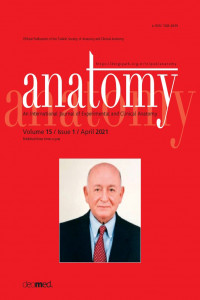Abstract
References
- Moore KL, Dalley AF, Agur AMR, editors. Clinically oriented anatomy clinical anatomy. 7th ed. Philadelphia (PA): Wolters Kluwer; 2017. p. 995–1004.
- Standring S, editor. Gray’s anatomy: The anatomical basis of clinical practice. 41st ed. London: Churchill Livingstone Elsevier; 2015. p. 406–14.
- Wineski L, editor. Snell’s clinical anatomy by regions. 10th ed. London: Wolters Kluwer; 2018. p. 1617–46.
- Paraskevas G, Natsis K, Ioannidis O, Kitsoulis P, Anastasopoulos N, Spyridakis I. Multiple variations of the superficial jugular veins: case report and clinical relevance. Acta Medica (Hradec Kralove) 2014;57:34–7.
- Abhinitha P, Rao MKG, Kumar N, Nayak SB, Ravindra SS, Aithal PA. Absence of the external jugular vein and an abnormal drainage pattern in the veins of the neck. OA Anatomy 2013;1:1–3.
- Kayiran O, Calli C, Emre A, Soy FK. Congenital agenesis of the internal jugular vein: an extremely rare anomaly. Case Rep Surg 2015;2015:637067.
- Uemura M, Takemura A, Tamada Y, Toda I, Ike H, Suwa F. A case of right partial and double internal jugular veins. Anat Sci Int 2006;81:65–8.
- Lalwani R, Rana K, Das S, Khan R. Communication of the external and internal jugular veins: a case report. International Journal of Morphology 2006;24:721–2.
- Karapantzos I, Zarogoulidis P, Charalampidis C, Karapantzou C, Kioumis I, Tsakiridis K, Mpakas A, Sachpekidis N, Organtzis J, Porpodis K, Zarogoulidis K, Pitsiou G, Zissimopoulos A, Kosmidis C, Fouka E, Demetriou T. A rare case of anastomosis between the external and internal jugular veins. Int Med Case Rep J 2016;9:73–5.
- Gogna S, Gupta N. Cancer, neck resection and dissection. In: StatPearls [Internet]. Treasure Island (FL): StatPearls Publishing; 2021. Available from: https://www.ncbi.nlm.nih.gov/books/NBK536998/
- Koroulakis A, Jamal Z, Agarwal M. Anatomy, head and neck, lymph nodes. In: StatPearls [Internet]. Treasure Island (FL): StatPearls Publishing; 2021. Available from: https://www.ncbi.nlm.nih.gov/books/NBK513317/
- Conley J. Radical neck dissection. Laryngoscope 1975;85:1344–52.
- Harish K. Neck dissections: radical to conservative. World J Surg Oncol 2005;3:21.
Abstract
The external jugular vein is a superficial vein that has a relatively diagonal to vertical course in the neck region and runs superficial to the sternocleidomastoid muscle. This vein is formed by the union of the posterior division of the retromandibular vein with the posterior auricular vein and it is responsible for draining most of the scalp and face as well. Sound knowledge of variations of the external jugular veins and the internal jugular veins, is important as these veins are used or targeted in specific medical procedures such as external jugular vein cannulation or radical neck dissection, respectively. During routine postgraduate dissection of the neck region in a 58-year-old female cadaver, the right external jugular vein was seen communicating with the right internal jugular vein via a communicating vein. The communicating vein was located approximately at the lower border of the thyroid cartilage and the upper border of the cricoid cartilage. A thorough understanding of anatomical variations is important in various medical disciplines and more specifically to anatomists, radiologists, and surgeons. This case report does not solely aim to increase awareness regarding variations of the jugular veins that can be possibly encountered during a neck endovascular procedure, but also contribute to the identification of the prevalence rate of this variation.
References
- Moore KL, Dalley AF, Agur AMR, editors. Clinically oriented anatomy clinical anatomy. 7th ed. Philadelphia (PA): Wolters Kluwer; 2017. p. 995–1004.
- Standring S, editor. Gray’s anatomy: The anatomical basis of clinical practice. 41st ed. London: Churchill Livingstone Elsevier; 2015. p. 406–14.
- Wineski L, editor. Snell’s clinical anatomy by regions. 10th ed. London: Wolters Kluwer; 2018. p. 1617–46.
- Paraskevas G, Natsis K, Ioannidis O, Kitsoulis P, Anastasopoulos N, Spyridakis I. Multiple variations of the superficial jugular veins: case report and clinical relevance. Acta Medica (Hradec Kralove) 2014;57:34–7.
- Abhinitha P, Rao MKG, Kumar N, Nayak SB, Ravindra SS, Aithal PA. Absence of the external jugular vein and an abnormal drainage pattern in the veins of the neck. OA Anatomy 2013;1:1–3.
- Kayiran O, Calli C, Emre A, Soy FK. Congenital agenesis of the internal jugular vein: an extremely rare anomaly. Case Rep Surg 2015;2015:637067.
- Uemura M, Takemura A, Tamada Y, Toda I, Ike H, Suwa F. A case of right partial and double internal jugular veins. Anat Sci Int 2006;81:65–8.
- Lalwani R, Rana K, Das S, Khan R. Communication of the external and internal jugular veins: a case report. International Journal of Morphology 2006;24:721–2.
- Karapantzos I, Zarogoulidis P, Charalampidis C, Karapantzou C, Kioumis I, Tsakiridis K, Mpakas A, Sachpekidis N, Organtzis J, Porpodis K, Zarogoulidis K, Pitsiou G, Zissimopoulos A, Kosmidis C, Fouka E, Demetriou T. A rare case of anastomosis between the external and internal jugular veins. Int Med Case Rep J 2016;9:73–5.
- Gogna S, Gupta N. Cancer, neck resection and dissection. In: StatPearls [Internet]. Treasure Island (FL): StatPearls Publishing; 2021. Available from: https://www.ncbi.nlm.nih.gov/books/NBK536998/
- Koroulakis A, Jamal Z, Agarwal M. Anatomy, head and neck, lymph nodes. In: StatPearls [Internet]. Treasure Island (FL): StatPearls Publishing; 2021. Available from: https://www.ncbi.nlm.nih.gov/books/NBK513317/
- Conley J. Radical neck dissection. Laryngoscope 1975;85:1344–52.
- Harish K. Neck dissections: radical to conservative. World J Surg Oncol 2005;3:21.
Details
| Primary Language | English |
|---|---|
| Subjects | Health Care Administration |
| Journal Section | Case Reports |
| Authors | |
| Publication Date | April 29, 2021 |
| Published in Issue | Year 2021 Volume: 15 Issue: 1 |
Cite
Anatomy is the official journal of Turkish Society of Anatomy and Clinical Anatomy (TSACA).

